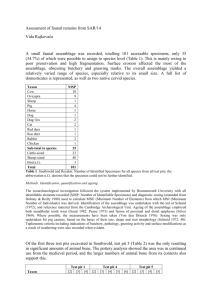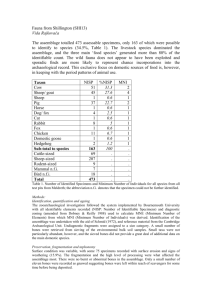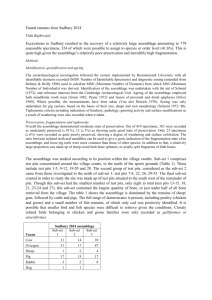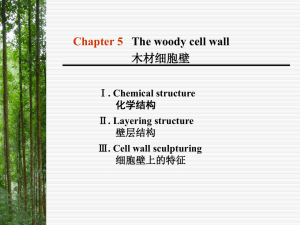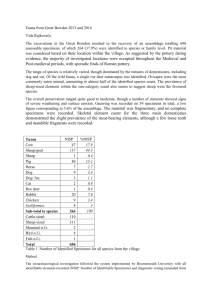Assessment of faunal remains from NAY14 Vida Rajkovača
advertisement
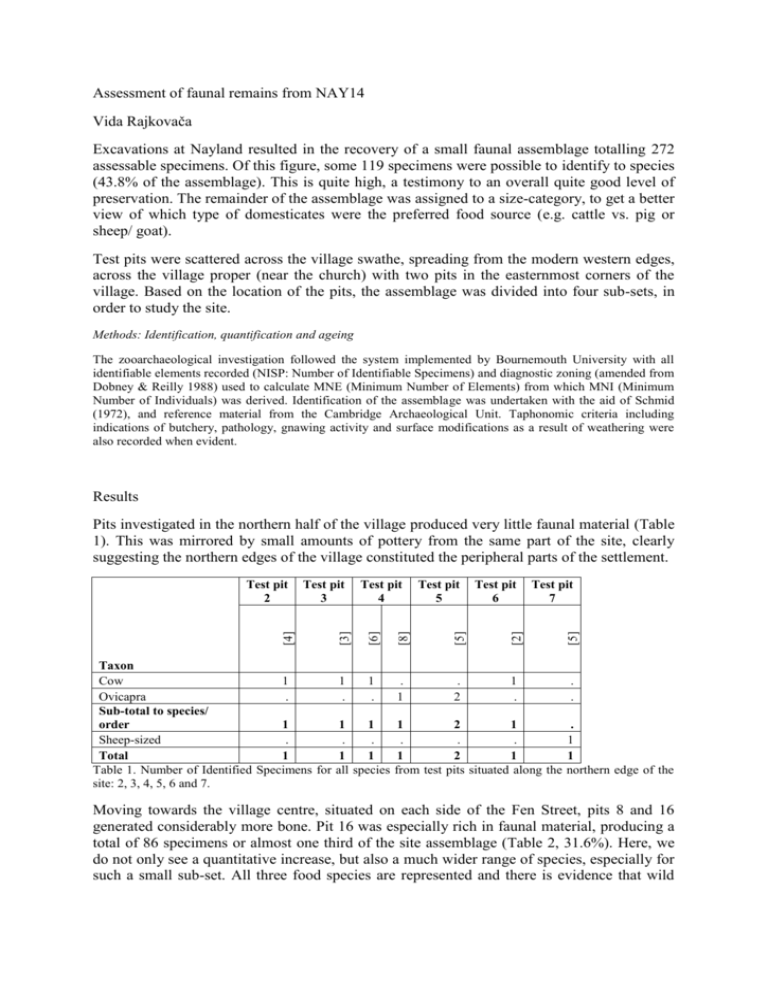
Assessment of faunal remains from NAY14 Vida Rajkovača Excavations at Nayland resulted in the recovery of a small faunal assemblage totalling 272 assessable specimens. Of this figure, some 119 specimens were possible to identify to species (43.8% of the assemblage). This is quite high, a testimony to an overall quite good level of preservation. The remainder of the assemblage was assigned to a size-category, to get a better view of which type of domesticates were the preferred food source (e.g. cattle vs. pig or sheep/ goat). Test pits were scattered across the village swathe, spreading from the modern western edges, across the village proper (near the church) with two pits in the easternmost corners of the village. Based on the location of the pits, the assemblage was divided into four sub-sets, in order to study the site. Methods: Identification, quantification and ageing The zooarchaeological investigation followed the system implemented by Bournemouth University with all identifiable elements recorded (NISP: Number of Identifiable Specimens) and diagnostic zoning (amended from Dobney & Reilly 1988) used to calculate MNE (Minimum Number of Elements) from which MNI (Minimum Number of Individuals) was derived. Identification of the assemblage was undertaken with the aid of Schmid (1972), and reference material from the Cambridge Archaeological Unit. Taphonomic criteria including indications of butchery, pathology, gnawing activity and surface modifications as a result of weathering were also recorded when evident. Results Pits investigated in the northern half of the village produced very little faunal material (Table 1). This was mirrored by small amounts of pottery from the same part of the site, clearly suggesting the northern edges of the village constituted the peripheral parts of the settlement. [2] [5] Test pit 7 [5] Test pit 6 [8] Test pit 5 [6] Taxon Cow 1 Ovicapra . Sub-total to species/ order 1 Sheep-sized . Total 1 Table 1. Number of Identified Specimens for site: 2, 3, 4, 5, 6 and 7. Test pit 4 [3] Test pit 3 [4] Test pit 2 1 . 1 . . 1 . 2 1 . . . 1 1 . . 1 1 all species 1 2 1 . . . 1 2 1 from test pits situated along the . 1 1 northern edge of the Moving towards the village centre, situated on each side of the Fen Street, pits 8 and 16 generated considerably more bone. Pit 16 was especially rich in faunal material, producing a total of 86 specimens or almost one third of the site assemblage (Table 2, 31.6%). Here, we do not only see a quantitative increase, but also a much wider range of species, especially for such a small sub-set. All three food species are represented and there is evidence that wild fauna was occasionally used. Another indication of other faunas playing part in their diet was indicated by the presence of fish remains. A cow metacarpus from test pit 16 ([8]) was recorded with osteochondritis dissecans in the proximal articulate surface. This condition manifests itself as lesions which result as herniation of small portions of the joint cartilage through the articular surface of the bone, probably appearing from sudden physical stress or trauma to the joint (Dobney et al.1996, 38). A cow mandible was aged as adult, and a sheep mandible gave the age at death of 6-8 years, both suggesting animals were kept into maturity for reproduction and secondary products. Chop marks were more common than fine knife marks, though this may be a bias as finer knife marks could have been obliterated by gnawing or surface erosion recorded in the assemblage. A more intense occupation was also visible in the amount and the character of pottery deposition. It is possible that the prevalent sheep recorded within context [9] hints at the importance of wool in the medieval period. [10] [9] [8] [7b] [7a] [6] [5] [4] [3] [5] Test pit 16 [4] [3] [2] [1] Test pit 8 Taxon Cow 1 . . 1 . . 3 1 . 1 . 3 2 . Ovicapra 2 . . . . 2 1 2 3 1 . 2 14 . Pig . . . . . 1 . 1 2 2 . . . . Deer sp. . . . . . . . . . . 1 . . . Rabbit . . . . . . . . . 1 . . . . Cat . . . . . . 1 . . . . . . . Mallard . . . . . . . . 1 . . . . . Anseriformes . . . . . . . 3 . . . . . . Sub-total to species/ order 3 . . 1 . 3 5 7 6 5 1 5 16 . Cattle-sized . . . 2 2 2 2 2 2 . . . 1 1 Sheep-sized . 2 1 4 . 5 1 1 3 3 . 2 8 1 Bird n.f.i. . . . . . . . . 2 . . . . . Fish n.f.i. . . . . . . . 1 1 . . . . . Total 3 2 1 7 2 10 8 11 14 8 1 7 25 2 Table 2. Number of Identified Specimens for all species from test pits situated on both sites of the Fen Street: 8 and 16. The abbreviation n.f.i. denotes that the specimen could not be further identified. The next sub-set represents the material recovered from pits grouping in the eastern corner of the village: 9, 10, 11 and 12. Pits 9 and 10 contained a negligible amount of bone, and only one specimen was identified to species (Table 3), though one interesting fragment came from pit 9. It was a cattle-sized long bone fragment which appeared to show signs of working, as it if had been fashioned into a tool. Only a small fragment survived, making it impossible to interpret it further. Given that these four pits contained significantly more pottery dating evidence, than animal bone, it could be argued that the area saw some marginal activity during the medieval and Post-medieval period. [5] [3] [3] Test pit 10 [2] [1] Test pit 9 Taxon Pig . . . 1 . Sub-total to species/ order . . . 1 . Cattle-sized 1 . 2 . 1 Sheep-sized . 1 . . . Total 1 1 2 1 1 Table 3. Number of Identified Specimens for all species from test pits 9 and 10. [12] [11] [10] [4] [3] [2] [10] [9] [8] Test pit 12 [7] [6] [5] [4] [3] [2] [1] Test pit 11 Taxon Cow . 2 1 . 2 1 . 1 1 1 . . . . . . Ovicapra . . 1 . 1 3 . . . 1 . . 1 . 1 . Sheep . . . . . . . . . 2 . . . . . . Pig . . . 1 1 . . . . . . 1 . 1 . 1 Subtotal to species/ order . 2 2 1 4 4 . 1 1 4 . 1 1 1 1 1 Cattlesized . 1 1 1 2 1 1 1 3 2 . . . 1 . . Sheepsized 1 . . . 2 2 1 . . . . 1 . 2 . . Bird n.f.i. . . . . . . . . . . 1 . . . . . Total 1 3 3 2 8 7 2 2 4 6 1 2 1 4 1 1 Table 4. Number of Identified Specimens for all species from test pits 11 and 12. The abbreviation n.f.i. denotes that the specimen could not be further identified. The final sub-set was made up of material from the three test pits excavated in the centre of the village. All three generated a combined total of 109 specimens or just over 40% of the assemblage (Tables 5 and 6). The village proper must have been the focus of activities, though the range of exploited species is somewhat basic, showing a heavy reliance on domestic sources of food. There are other aspects of the assemblage which evidently categorise the assemblage as domestic, such as butchery marks. A few thoracic vertebrae were chopped down the sagittal plane suggesting carcasses were hung and chopped to split into left and right portion during the disarticulation and portioning process. This butchery action became especially popular during the 15th century, though it had been recorded from some Iron Age assemblages. The splitting was done somewhat off-centre, indicating blades were either not sharp or not heavy enough to cut through thick vertebrae centrum. Pottery dating evidence suggested the faunal remains represent the remains of an intensive occupation, accumulated over a longer period of time. Though sheep appear to be marginally more common, cattle must have been the main providers of meat. In keeping with the period, wild faunal resources do not seem to have been utilised. Taxon Test pit 13 Test pit 14 [12] [11] [10] [9] [8] [6] [5] [4] [3] [2] [1] [6] [5] [4] [3] [2] [1] Cow . . 1 . . . . 1 . 1 . 1 3 1 . . . Ovicapra . 2 . . 5 1 . 2 . . . . . 2 2 . . Pig . . . . 1 . . . . 1 . . 1 . . . . Rabbit . . . . . 1 . . . . . . . . . . . Chicken . . . . . . . . . . . 1 . . . . . Sub-total to species/ order . 2 1 . 6 2 . 3 . 2 . 2 4 3 2 . . Cattle-sized . . 1 . 1 1 . . . . 1 . 2 1 . . . Sheep-sized . 2 2 . . 2 2 . 3 1 1 1 1 4 . 3 1 Mammal n.f.i. 2 . . 3 . . . . . . . . . . . . . Bird n.f.i. . . 1 1 . . . . . . . 1 . . . . . Total 2 4 5 4 7 5 2 3 3 3 2 4 7 8 2 3 1 Table 5. Number of Identified Specimens for all species from test pits 13 and 14. The abbreviation n.f.i. denotes that the specimen could not be further identified. [10] [12] Taxon Cow . . . . . . . 1 Ovicapra . . . . . 1 . . Pig . . . . 1 2 . . ?Rat . 1 1 . . . . . Sub-total to species/ order . 1 1 . 1 3 . 1 Cattle-sized . . . . 1 2 . 1 Sheep-sized 1 6 2 4 4 4 1 2 Rodent-sized . 1 1 . . . . . Total 1 8 4 4 6 9 1 4 Table 6. Number of Identified Specimens for all species from test pit 15. [9] [8] [7b] [7a] [6] [5] [4] [3] [1] Test pit 15 1 . . . . . . . . . . . 1 . 1 . 2 . . 2 . 2 . 1 2 . 3 Bibliography: Dobney, K., and Reilly, K., 1988. A method for recording archaeological animal bones: the use of diagnostic zones, Circaea 5 (2): 79-96. Dobney, K., Jaques, D., & Irving, B. G. 1996. Of butchers & breeds: report on vertebrate remains from various sites in the city of Lincoln (No. 5). City of Lincoln Archaeological Unit. Schmid, E. 1972. Atlas of animal bones. Amsterdam: Elsevier.
